 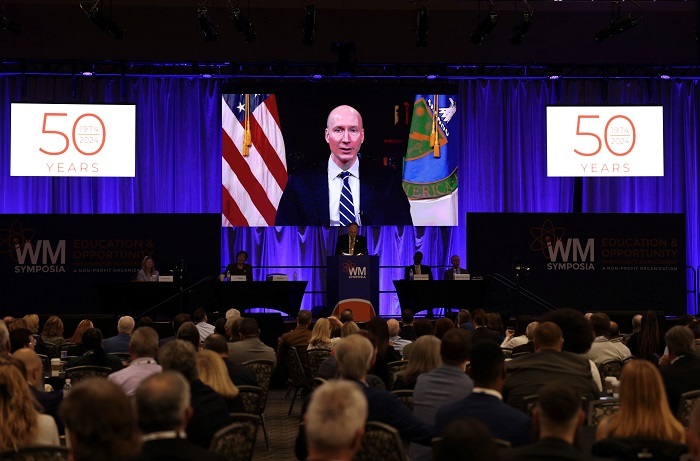 U.S. Deputy Energy Secretary David Turk provides remarks to Waste Management Symposia participants in a prerecorded video. The screens on each side of Turk note Waste Management's 50th anniversary this year.
PHOENIX — In the half century since the inception of the Waste Management Symposia, many EM sites have come full circle, cleaned and transformed into wildlife refuges, wetland preserves and national parks, U.S. Deputy Energy Secretary David Turk remarked Monday in a prerecorded video message to the audience at the annual conference.
“And now, together with our community partners, we’re looking even further into the future,” Turk said. “We’re exploring how our sites could become new hubs of economic development — with an eye towards national security, clean energy and innovation.”
Turk and EM Senior Advisor William “Ike” White shared remarks with conference-goers during their first full day at the event as Waste Management Symposia marks its 50th anniversary this year.
There were 200 participants in the inaugural conference in 1974, a stark contrast to the more than 3,300 attendees from 29 countries at this year’s symposium — a record attendance for the event.
In their addresses, the DOE officials noted significant cleanup achievements from 2023 — another banner year for EM — such as the treatment of billions of gallons of contaminated groundwater.
And they also painted a picture of the cleanup program’s vast progress reshaping sites over the past decades. For example, as White noted, the Fernald Site in Ohio was still turning out uranium products during the first Waste Management conference in 1974. But after dismantling 323 buildings, excavating and shipping 1 million tons of waste and treating a 225-acre plume of contamination, the site is now home to one of the largest manmade wetlands in Ohio.
Although cleanup will continue in the years ahead, EM progress has opened opportunities for clean energy development, national security priorities, scientific research and economic growth.
"While we have decades of cleanup to come at some sites, because of our workers, because of this team, the cleanup mission has now matured to the point where we can dream big about the future," Turk said. “We can dream big about all the ways these sites can once again be put to work for the American people, and people around the world.”
Turk then turned his attention to the students and early career professionals in the audience.
“You are entering this workforce at a unique time. We will need your expertise, your perspectives and ideas to help us bring these big dreams to life," he said. "So I urge you to take full advantage of this week. Talk to panelists, talk to your peers, come talk to DOE about what your career could look like in this space. We can’t wait to have you in our ranks."
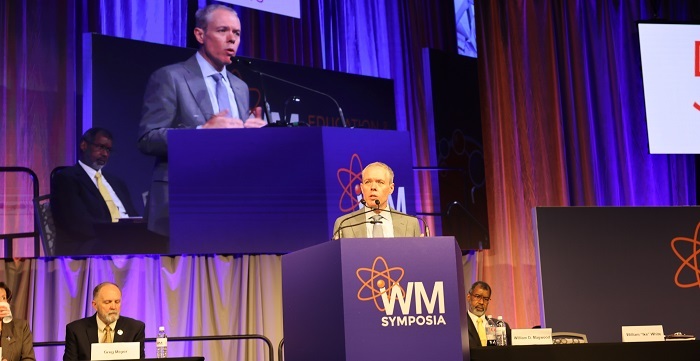 EM Senior Advisor William "Ike" White speaks to attendees of the Waste Management conference during the plenary session Monday..
Echoing Turk’s sentiment, White noted that the catchphrase, “Proud of our Past, Poised for the Future,” is as fitting for EM as it is for the 50th anniversary of Waste Management.
In his address, White discussed EM’s Strategic Vision 2024-2034, newly updated just in time for the conference, where the inaugural document debuted in 2020.
"As we approach the halfway point of the decade that was laid out in the vision document, we have delivered on the priorities that were outlined in the plan," White said.
"Game-changing tank waste treatment capabilities are now in place to address EM’s largest environmental liability," White said. "With the startup of the Salt Waste Processing Facility, a full suite of tank waste treatment capabilities is in place at Savannah River, treating nearly 6 million gallons of waste per year."
The head of EM listed numerous other accomplishments across the EM complex, illustrating the fact that the cleanup program is no longer mapping out the road to cleanup.
"EM and our industry partners are safely executing cleanup, fulfilling obligations and continuing a steady beat of progress with a shift to long term operations," he said.
Looking to the future, White emphasized EM’s need for thousands of operators, rad techs, electricians, project controls analysts, managers, mechanics and planners over the next five years alone. In conjunction with the Energy Facility Contractors Group, EM compiled projections for workforce needs across cleanup sites.
“With greater knowledge of the jobs and skills that we need, we also have an opportunity to do more to help shape workforce development to be able to meet those needs,” he said. “The projections we have hopefully will be instrumental as we partner with local communities where workforce development often begins.”
The talent pool at the Waste Management conference, though, is always impressive, White said. He noted the job fair at the symposium and added that EM is hiring.
In closing, White told the audience that EM would not be where it is today without its dedicated federal workforce, industry partners, state and other government regulators, community and tribal partners, and international partners — as well as the early career professionals who will carry on the tradition of Waste Management and will be the leaders of the cleanup program for decades to come.
"From the very first Waste Management Symposium in 1974 to today, you played key roles in getting to this point where we’re making steady progress, preparing for the future," he said. "Our collective attention to that progress, as well as broader priorities, will be important as we look to the next 50 years and beyond."
-Contributors: Matt Roberts, David Sheeley
 
You may have seen the movie about Oppenheimer but how much Manhattan Project history do you really know? Are you up for a challenge to find out?
The Manhattan Project is the EM origin story, resulting in the world's largest cleanup effort, so we have created the ultimate fact vs. fiction quiz to test your knowledge. Challenge yourself with the quiz and explore the website to find documentaries, blog posts and articles that take you back in time to learn more about one of the most transformative events of the 20th century. Click the blue box to explore:
-Contributor: Kyle Hendrix
 
WASHINGTON, D.C. — Community leaders from Paducah, Kentucky, met with leaders from EM and DOE’s Office of Nuclear Energy (NE) last week to discuss the path forward for making Paducah a “Nuclear Ready Community.” Members of the Paducah Area Chamber of Commerce traveled to Washington, D.C., to meet with members of Congress as well as officials from DOE and other federal agencies. “We clean up for the community,” EM Senior Advisor William “Ike” White said to the community members. “Community involvement is always an emphasis for us.” Pictured from left are Kristen Ellis, associate principal deputy assistant secretary for EM’s Office of Regulatory and Policy Affairs and EM acting director of regulatory, intergovernmental, and stakeholder engagement; Rob Gentry, Paducah Site plant manager, Mid-America Conversion Services; Cory Hicks, business services director, Four Rivers Nuclear Partnership (FRNP); Maegan Mansfield, project manager for the Paducah DOE Reindustrialization Study, Bacon Farmer Workman Engineering and Testing; Sandra Wilson, president and CEO of the Paducah Area Chamber of Commerce and mayor pro tem for the City of Paducah; White; Jeff Avery, EM principal deputy assistant secretary; Craig Clymer, judge-executive, McCracken County Fiscal Court; Bruce Wilcox, president and CEO, Greater Paducah Economic Development; Myrna Redfield, president and CEO, FRNP; and Cheryl Moss-Herman, senior advisor, NE.
  Joshua Dickinson, left, Savannah River Mission Completion electrician and School of Hazards volunteer, leads a group of craft employees through the course.
AIKEN, S.C. — EM’s liquid waste contractor at the Savannah River Site (SRS) is educating workers on everyday workplace hazards with a hands-on, peer-led mobile field course.
The new course, “School of Hazards,” is encouraging safe practices by immersing construction craft employees in a mock-up of hazardous scenarios. The outdoor obstacle course comprises simulated hazards workers might encounter in their jobs, including barricades, tripping hazards, damaged equipment and more.
Projects within the SRS Liquid Waste Program, managed by EM liquid waste contractor Savannah River Mission Completion (SRMC), consist of ongoing construction, high-hazard and radioactive operations and maintenance tasks, and treating and immobilizing radioactive liquid waste stored in the SRS Tank Farms. SRMC employs over 800 construction craft employees to support its mission. The School of Hazards has traveled to four areas in SRS that host the liquid waste facilities.
The School of Hazards was created and is facilitated by one of SRMC’s employee-led safety teams, known as Local Safety Improvement Teams at SRS. The teams are an organized group dedicated to an area or facility, with the purposes of facilitating the behavior-based observation program, developing behavior-focused initiatives, serving as a management-worker communication bridge and fostering worker involvement to achieve the goal of zero injuries.
According to Jim Folk, DOE-Savannah River assistant manager for waste disposition, ensuring safety in all operations is a priority for EM.
“Safe construction and operations are necessary to process radioactive liquid waste for final disposition,” said Folk. “EM supports every effort to keep workers safe.”
Employees are guided through the course by a representative from the construction craft’s Local Safety Improvement Team, called “SAFE-T,” who interacts with participants by discussing the hazards and how to handle them.
The purpose of this initiative is to help heighten the awareness of workers in the field, according to Brandon Johnson, SAFE-T chair and SRMC electrician.
“This School of Hazards course helps our construction team to identify hazards and understand the process of mitigating any hazard they may face,” Johnson said. “Our goal is for every worker to go home in the same state they came to work.”
According to Dave Olson, SRMC president and program manager, the initiative offers an additional avenue for employees to be immersed in SRMC’s safety culture.
“This safety initiative is an innovative way to interact with employees, both new and experienced,” Olson said. “SRMC is committed to doing the job safely, and we are proud to support initiatives that can better equip employees.”
Click the blue box below to hear from the SAFE-T chair and co-chair:
-Contributor: Lindsey Kennedy
 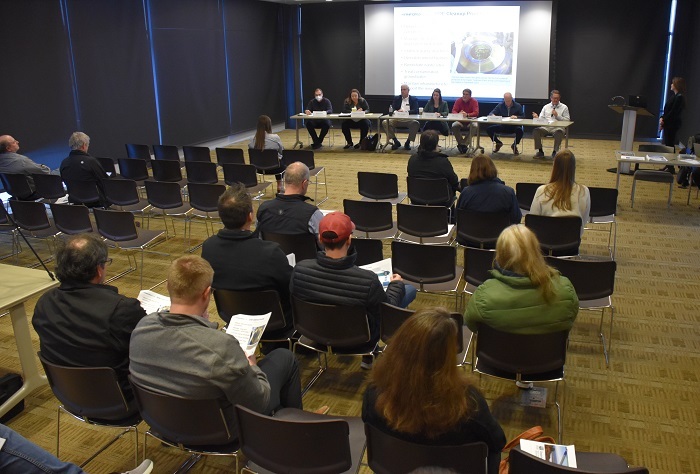
RICHLAND, Wash. — Representatives from the Department of Energy (DOE), in partnership with the U.S. Environmental Protection Agency and Washington State Department of Ecology, hosted the fiscal year 2026 Hanford Site Cleanup Priorities public briefing on March 6 at the Richland Public Library. DOE representatives provided an overview of Hanford’s current projects, including tank waste treatment, Central Plateau and Columbia River risk reduction, and mission and site infrastructure. The overview was followed by a Q&A session with members of the public attending the meeting. Feedback collected during the 30-day comment period that continues through April 5 will be used to help with the fiscal year 2026 budget submission for the Hanford Site.
-Contributor: Shane Edinger
  The 2024 DOE South Central Ohio Regional Science Bowl participants pose for a group photo. This year’s event set a participation record with 18 schools and 32 teams from Scioto, Pike, Ross and Jackson counties.
PIKE COUNTY, Ohio — Valley High School Team 2 recently captured first place in the 12th annual DOE South Central Ohio Regional Science Bowl, marking the second time in the last three years the school has won the event. With the victory, the team advances to the National Science Bowl competition held in Washington, D.C., April 25-29.
“We are thrilled to win this year's competition,” Valley High School Coach Justin Howard said of the regional event, which saw a record number of participants. “I am proud of our teams for their hard work and look forward to representing our region at the National Science Bowl.”
Schools have the option to enter up to three teams in the competition. Minford High School Team 2 finished in second place, and Valley High School Team 1 and Northwest High School Team 2 advanced to the semifinals.
The regional competition drew 18 schools and 32 teams from Scioto, Pike, Ross and Jackson counties at Shawnee State University.
 Students from Valley High School Team 2 and Northwest High School Team 2 await to begin their semifinal match during the 12th annual DOE South Central Ohio Regional Science Bowl. Valley High School Team 2 won this year’s competition.
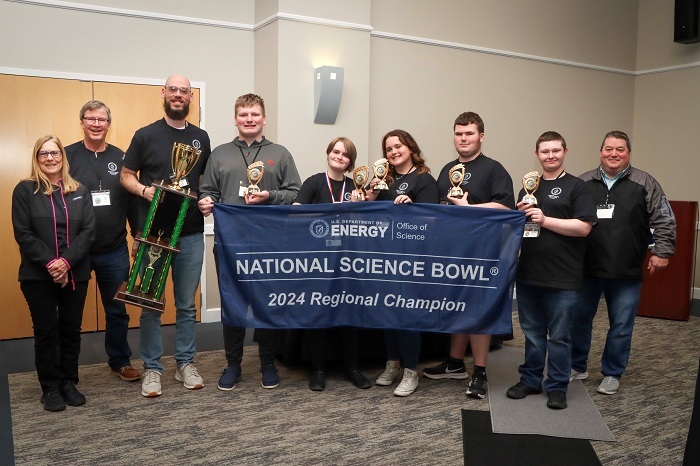 Valley High School Team 2 members display their trophies and championship banner after winning the 12th annual DOE South Central Ohio Regional Science Bowl. From left: Fluor- BWXT Portsmouth Chief Operating Officer Kliss McNeel, EM Federal Project Director Jud Lilly, Valley Coach Justin Howard, Allen Smith, Aria Bradley, Annika Carpenter, Zachary Brown, Andrew Rose and EM Program Analyst Greg Simonton.
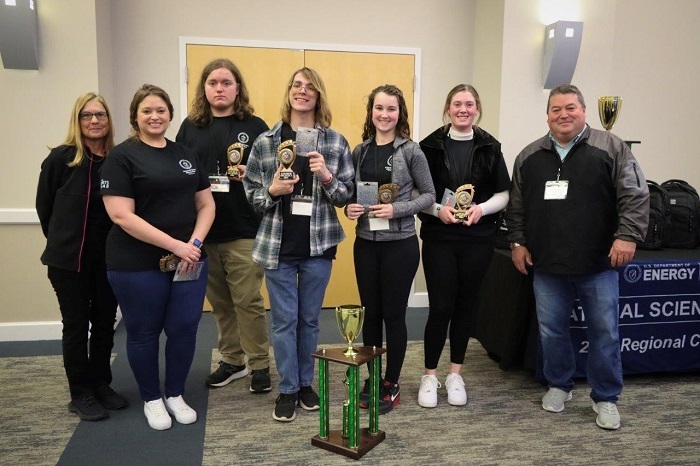 Runners-up of the 12th annual DOE South Central Ohio Regional Science Bowl, Minford High School Team 2, pose for a photograph with their trophies. From left: Fluor- BWXT Portsmouth Chief Operating Officer Kliss McNeel, Minford Coach Megan Mitchell, Chase Fisher, Zach Fleenor, Claire Clevenger, Hannah Stockham and EM Program Analyst Greg Simonton.
“These students work hard to prepare for this competition and do an outstanding job representing our communities,” EM Portsmouth Site Lead Jeremy Davis said. “Best of luck to Valley High School Team 2 as they advance to the national competition.”
DOE created the National Science Bowl in 1991 to encourage students to pursue careers in math and science. More than 344,000 students have participated in the National Science Bowl throughout its history. It’s one of the nation’s largest science competitions.
 |
|
Catch up on recent EM Update coverage of other DOE regional science bowl victories here and here. The competitions were sponsored and organized by EM Portsmouth/Paducah Project Office employees and contractors.
|
More than 60 people from Portsmouth Site volunteered as moderators, time-keepers, rules judges and runners for the event.
“Because of the teamwork, the event ran like clockwork,” said Kliss McNeel, deputy site director for Fluor- BWXT Portsmouth, EM’s deactivation and demolition contractor at the Portsmouth Site. “We have an amazing group at the site. It’s extraordinary what we can do when we pull together for our community.”
-Contributor: Shawn Jordan
 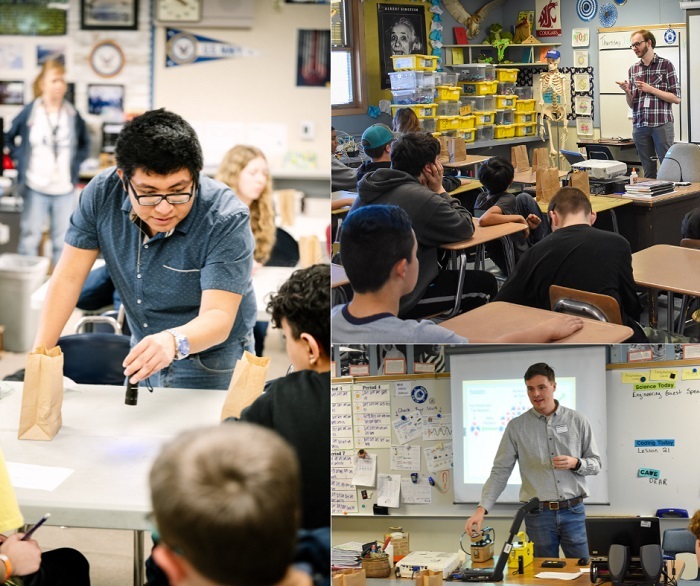 Hanford Site Waste Treatment and Immobilization Plant engineers, clockwise, from left, LJ Rotness, Jeff Eakin and Logan Anspach were among the more than 40 plant volunteers who visited local classrooms during National Engineers Week.
More than 40 engineers from the Hanford Site’s Waste Treatment and Immobilization Plant (WTP) recently volunteered at 13 schools for DiscoverE Engineering’s National Engineers Week.
The volunteers spent time in classrooms educating students on engineering careers and led a variety of hands-on science, technology, engineering and math (STEM) activities.
One activity involved the students "purchasing" materials from a nuclear quality vendor that were needed to safely remove a pingpong ball from a brown bag containing "radioactive powder," and transfer it to another bag without any spillage. Volunteers verified if any powder was dropped as the students transferred the ball between bags.
Mat Irwin, acting assistant manager for WTP at Hanford, emphasized the importance of outreach opportunities such as Engineers Week for fostering connections between the Hanford workforce and the community.
"Not only does Engineers Week allow us to educate kids about the world of engineering, but it also helps us cultivate the next generation of engineers at Hanford," said Irwin.
 |
|
In a recent centerpiece story, EM Update spotlighted five engineers across the cleanup complex for National Engineers Week. Read it here:
|
Beyond the classroom, WTP engineers organized Engineers Week activities at a public library and a Boys & Girls Club. The library event, known as DiscoverE Girl Day, was intended to engage and educate girls of all ages about engineering, and was attended by more than 100 girls. WTP engineers set up tables with engineering activities, which included drawing color-coded patterns where small robots could follow the patterns and building electric circuits by using conductive modeling clay.
Volunteers also introduced the pingpong ball and circuit activity to middle and high school students at the Boys & Girls Club. In addition to providing these interactive engineering activities, the engineers discussed the importance of soft skills — intangible skills like critical thinking, teamwork and effective communication — which are part of the club’s Workforce Readiness Program, sponsored by WTP lead contractor Bechtel National Inc.
Jeff Dahl, radiological engineering group supervisor for Bechtel, coordinated the volunteers and expressed his satisfaction with this year’s event.
"It was fantastic to see our engineers engaging with the community and creating excitement about engineering with local kids,” said Dahl. “Engineers Week provides us with an opportunity to introduce STEM activities to kids and educate them on the possibilities within the field of engineering.”
-Contributor: Tyler Oates
 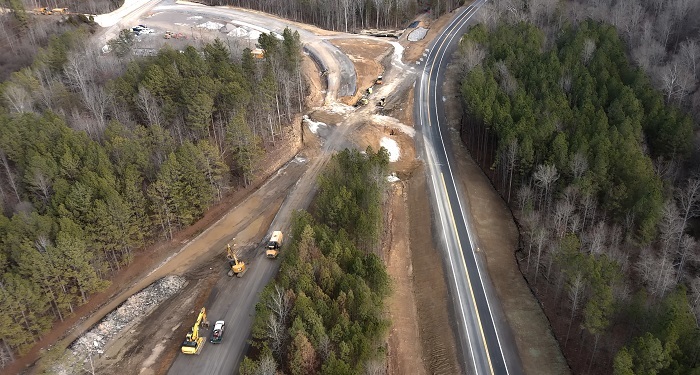 Early site preparation activities for Oak Ridge’s Environmental Management Disposal Facility are scheduled to be complete this spring. One of the major tasks involved moving Bear Creek Road and Haul Road.
OAK RIDGE, Tenn. – The Oak Ridge Office of Environmental Management (OREM) and contractor UCOR have initiated the second phase of construction for the Environmental Management Disposal Facility (EMDF).
OREM’s current onsite disposal facility is nearing full capacity after 20 years of safe operations. However, hundreds of buildings are slated for demolition in the future at the Y-12 National Security Complex and Oak Ridge National Laboratory.
The EMDF project is essential because it provides the waste disposal capacity necessary to complete cleanup at those sites.
The initial phase of construction, early site preparation, started in August, and those activities are slated for completion this spring. The work involves moving Bear Creek Road and Haul Road.
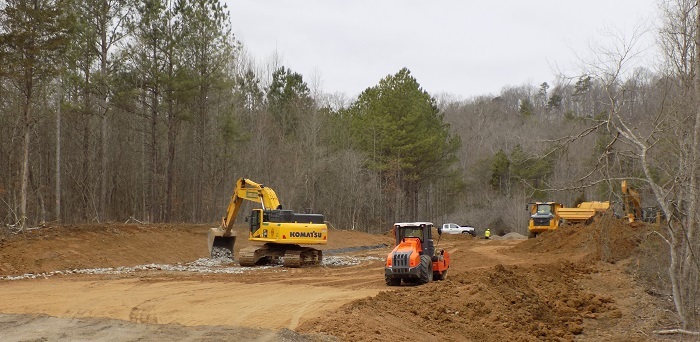 EM crews are moving dirt for a groundwater field demonstration study. The study takes place on a portion of the footprint for the future Environmental Management Disposal Facility. Oak Ridge will gather data for two wet seasons to inform the final design for the facility’s construction.
The second construction phase focuses on a groundwater field demonstration study subproject. It involves tree felling, which began in recent weeks, earthwork and groundwater monitoring for two wet seasons.
The purpose of the subproject is to allow OREM to confirm its modeling by providing real-world data of how groundwater levels will adjust when EMDF’s construction begins. OREM and UCOR will use data captured from the study to inform and make any adjustments needed on the facility’s final design.
“The groundwater field demonstration gives us additional confidence and will inform final design choices for EMDF, and it is critical to maintaining our schedule and bringing this facility online to support cleanup in Oak Ridge,” said Mary Magleby, UCOR project manager for the EMDF project.
The concluding phase of this project will include completing the final design and constructing the facility’s first two disposal cells. There will be four disposal cells in total.
With oversight from the U.S. Environmental Protection Agency and Tennessee Department of Environment and Conservation, OREM will incorporate numerous engineering features into EMDF’s design to ensure the waste remains isolated from the environment. Additionally, OREM will continue sending all highly contaminated waste out of state for disposal.
UCOR awarded the $20 million subcontract for the groundwater field demonstration study to minority-owned small business CTI and Associates.
-Contributor: David Barton
 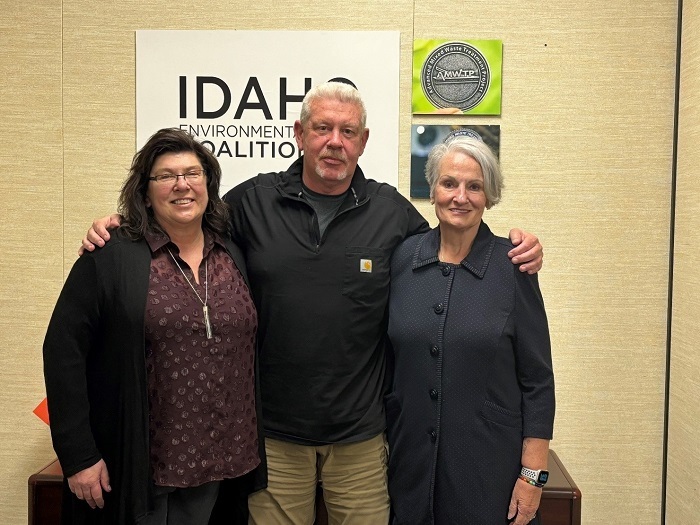 Pictured from left: MarCom President Marcella Medor, Idaho Environmental Coalition (IEC) President and Program Manager Ty Blackford and IEC Supply Chain Management Senior Manager Shawna Southwick.
IDAHO FALLS, Idaho — EM’s cleanup contractor at the Idaho National Laboratory (INL) Site has partnered with an Idaho Falls-based small business through DOE’s Mentor-Protégé Program.
DOE's Office of Small and Disadvantaged Business Utilization (OSDBU) manages the Department's Mentor-Protégé Program. The program seeks to foster long term business relationships between small businesses and DOE prime contractors and to increase the number of small businesses that receive DOE prime contracts and subcontracts.
Under the program agreement, Idaho Environmental Coalition (IEC), the mentor, will provide employees with MarCom, the protégé, with onsite work experience and business development expertise to enhance the company’s ability to bid on future federal contracts.
This is the first of two mentor-protégé agreements that IEC will sign with small businesses, and IEC recognizes that the Mentor-Protégé Program benefits both DOE contractors and small businesses.
“This program is designed to foster long term relationships between DOE prime contractors and small businesses, which provides mutual benefit to both parties,” IEC Small Business Liaison Elisabeth Warn said. “Small businesses bring significant economic value to the communities in which they are invested, and this program connects them to a larger portfolio of work."
Marcella Medor, MarCom president, sees great value in the opportunities the agreement provides.
“Our workforce has expertise in a number of skilled disciplines,” she said. “This mentorship provides an opportunity for our company to grow and develop skills that will make us more competitive as we bid for projects at other DOE sites.”
Founded in 2003, MarCom provides management, administrative, engineering, nuclear operations, and safety and health services to DOE sites throughout the country. It's a Native American- and woman-owned small business with additional offices in Butte, Montana, and Fort Collins, Colorado.
MarCom was also named the OSDBU 2019 Small Business of the Year.
In 2021, IEC was awarded a 10-year, $6.4 billion contract to manage cleanup at the INL Site, with a focus on early risk reduction and continued protection of the Snake River Plain Aquifer.
-Contributor: Carter Harrison
|





